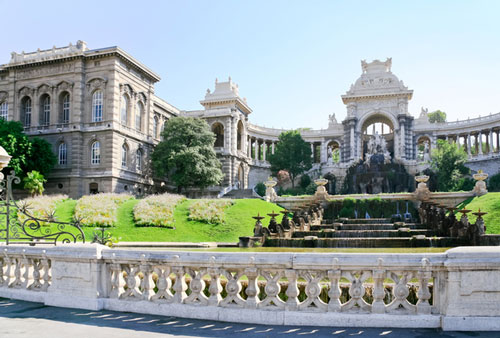Reading Comprehension Text and Exercises
Marseille
The City of 111 Districts
Marseille is the second-largest city in France. It is the largest city in the southern region of Provence. It lies on the shores of the Mediterranean Sea. The city has been a busy port since the time of Ancient Greece. In 2013, Marseille was chosen as the European Capital of Culture. Marseille is made up of 111 neighbourhoods.

Click Here for Step-by-Step Rules, Stories and Exercises to Practice All English Tenses
Etymology
The name Marseille is derived from Massalia. This was the name used for the city when it was first built by the Ancient Greeks. This name roughly translates as "city on the far end of the sea". It was given this name because it was a long way from the capital city of Ancient Greece.
A Brief History of Marseille
- Marseille was first built by settlers from Ancient Greece around the year 600 BCE. At this time, it was named Massalia. Massalia became home to many people who used to live in Phocea. Phocea was an ancient city located in modern-day Turkey.
This is the reason why the city is sometimes called "The Phocean city". Massalia was the most important Greek city in the region during this period. It was a powerful and independent city which traded with other cities across the Mediterranean Sea.
- In 49 BCE, Massalia was put under siege by the powerful Roman Republic. This meant that Massalia was surrounded by enemy troops and cut off from the outside world.
The Roman leader Julius Caesar made it impossible to bring in food and other supplies. Eventually, the city gave up. It was then made part of the Roman Empire.
- Massalia enjoyed centuries of peace and prosperity under Roman rule. However, the city was taken over by the Visigoths in the 5th century CE.
From around this time, the name "Marseille" became more widely used for the city. Although Marseille remained an important center for trading, it also suffered some difficult moments. It was badly damaged by an attack by the Frankish king Charles Martel in 739 CE.
- In the late medieval period the city was badly affected by the plague. This terrible disease killed more than half of the city's population during the 14th century.
Rene of Anjou, the Count of Provence, rebuilt large parts of the city in the mid-15th century. He strengthened its defensive walls and fortresses. As part of the Kingdom of France, Marseille became the base of the French Navy in the Mediterranean.
This meant it was responsible for building and looking after France's most important war ships.
- Marseille played a leading role during the French Revolution, which began in 1789. This important event meant the end of the French monarchy, a type of government led by a king or queen.
It was replaced with a republic, a type of government whose leaders are chosen by the people. The French national anthem, "La Marseillaise", was named after volunteers from Marseille. These brave soldiers marched from Marseille to Paris to fight.
- During the 19th century, Marseille became one of France's most important cities for manufacturing. The city became famous for producing goods such as chemicals, plastics, and ships. In recent years, Marseille has attracted many new arrivals.
The city is now home to thousands of people whose parents or grandparents originally came from the North African countries of Algeria and Morocco. Many of these people moved to the city in the mid and late twentieth century to work in Marseille's factories.
Notre-Dame de la Garde
This beautiful church is one of Marseille's best-known landmarks. Its name translates as "Our Lady of the Guard". "Our Lady" refers to the Virgin Mary, mother of Jesus Christ.
The church is built on the site of an ancient fort or castle. It stands at the highest point in Marseille, which means that it can be seen for miles around. The church took 21 years to complete.
Work on building the church began in 1852 and was finished in 1864. The building was designed by the French architect Henri-Jacques Esperandieu.
Notre-Dame de la Garde is a particularly popular place to visit on August 15th every year. This is when Catholics celebrate Assumption Day. This is the day when they believe that the Virgin Mary ended her life on earth and was taken up to heaven.
Museum of European and Mediterranean Civilizations
The Museum of European and Mediterranean Civilizations is one of Marseille's newest museums. The Museum first opened its doors in 2013. It was built as part of the celebration of Marseille being chosen as European Capital of Culture in the same year.
The museum tells the story of the history of the Mediterranean region. It allows visitors to learn about how different groups of people learned from each other over time to develop into the world we know today. The Museum is spread over two floors.
The building also contains a large auditorium, a room with a stage and seating for over 400 people where performances or talks can be held. It was designed by the French architects Rudy Ricciotti and Roland Carta.
The impressive building is located near the entrance to Marseille's harbor. When they are looking through the museum's windows out to the sea, visitors often think about how important the sea has been in shaping the city's history.
Palais Longchamp
The Palais Longchamp can be found in the 4th arrondissement (neighborhood) of Marseille. This beautiful palace was originally built to celebrate the construction of the Canal de Marseille.
The Canal took 15 years to build between 1834 and 1849. It brought fresh, clean water to the city from the mountains, which helped to improve the health of its people.
Before the canal was built, the people of Marseille were often worried about diseases like the plague and cholera. These sicknesses were spread by the use of dirty water when cooking and cleaning.
The palace took 30 years to complete. It is centered around an elaborate fountain known as the chateau d'eau, or "water castle". This impressive structure was designed to celebrate the arrival of fresh, clean water to the city. The palace is also home to two of Marseille's best museums.
The Musee des Beaux Arts, or Fine Arts Museum, is on the eastern side of the building. On the western side of the building is the Museum d'Histoire Naturelle, or Natural History Museum.
Chateau d'If
This impressive fortress is located on the small island of If. The island is around 1 mile (1.6 kilometers) from Marseille. The Chateau was built between 1524 and 1531, on the orders of King Francis I.
As well as serving as a base for French soldiers, the Chateau was also used as a prison. Its isolated location, surrounded by water, made it the ideal place to keep dangerous or valuable prisoners. T
he Chateau is the setting for part of the famous novel The Count of Monte Cristo by Alexander Dumas. In the book Dumas's main character, Edmond Dantes, is able to escape from the island. However in real life, it is thought that no prisoner ever managed to successfully get out.
The chateau's has not been used as a prison since the 1880s. In 1890 it has been open to the public and is now one of Marseille's most popular places to visit.
An Authentic Marseille Dish
Navettes are one of Marseille's most distinctive dishes. These small, hard biscuits are made with orange. They are cut into the shape of little boats. This shape was chosen because of Marseille's close relationship with the sea.
Navettes are eaten all year round in Marseille, but are especially popular around early February. This is because they are traditionally eaten after the Candlemas Procession. This is a Holy Day for Catholics who celebrate by bringing their candles to the church to be blessed. (A procession is a line of people who are going in the same direction.)
Comprehension Exercises
Vocabulary Questions
- What does "shores" mean?
- where the river meets the sea
- where the sea meets the sky
- where the land meets the sea
- What does "prosperity" mean?
- being rich
- being poor
- being unlucky
- What does "volunteers" mean?
- people who are paid to do a job
- people who climb trees
- people who do something for free
- What does "elaborate" mean?
- expensive and useless
- complicated and beautiful
- soft and fluffy
- What does "isolated" mean?
- far from anything else, remote
- cold and shivering
- broken or in pieces
Collocation Questions
- The city was ___________ the name Massalia by the Ancient Greeks.
- handed
- given
- donated
- Many people moved ___________ Phocea to Massalia in the 6th century BCE.
- of
- for
- from
- Massalia was ___________ by the Romans in 49 BCE.
- conquered
- won
- succeeded
- The King of France was removed during the French ___________.
- Spin
- Revolution
- Turn
- Marseille's harbor is one of the busiest on the Mediterranean ___________.
- River
- Lake
- Sea
- The church of Notre-Dame de la Garde stands on the ___________ of Marseille's tallest hill.
- peak
- tip
- uttermost
- Assumption Day is ___________ on August 15th every year by Marseille's Catholics.
- renowned
- famous
- celebrated
- The Museum of European and Mediterranean Civilizations was opened the ___________ year that Marseille was chosen as European Capital of Culture.
- same
- similar
- alike
- The Palais Longchamp was built to commemorate the construction of the Canal de Marseille, which brought ___________ water to Marseille from the mountains.
- exciting
- new
- fresh
- Alexander Dumas is the ___________ of The Count of Monte Cristo.
- architect
- author
- inventor
Wh Questions
- Which museum is housed on the eastern side of Palais Longchamp?
- Fine Arts Museum
- Natural History Museum
- Museum of European and Mediterranean Civilizations
- Why are navettes especially popular around early February?
- because they are traditionally eaten on Valentine's Day
- because they are traditionally eaten on Assumption Day
- because they are traditionally eaten after the Candlemas Procession
- Where did many new arrivals to Marseille during the second half of the twentieth century come from?
- North Africa
- North America
- Northern Australia
- How many prisoners escaped from the Chateau d'If?
- one
- none
- fourteen
- When was the Canal de Marseille completed?
- 1876
- 1866
- 1849
Evaluating Statements
- Based on the information in this lesson, which statement is true?
- The Palais Longchamp is in the 4th arrondissement.
- The Palais Longchamp is in the 9th arrondissement.
- Based on the information in this lesson, which statement is false?
- Henri-Jacques Esperandieu designed the church of Notre-Dame de la Garde.
- Henri-Jacques Esperandieu designed the Museum of European and Mediterranean Civilizations.
True or False?
- Based on the information in this lesson, is the following statement true or false?
"The Visigoths captured Marseille in the 6th century CE." - True
- False
- Based on the information in this lesson, is the following statement true or false?
"Rene of Anjou helped rebuild Marseille in the mid-15th century." - True
- False
Answer Key
1. C | 2. A | 3. C | 4. B | 5. A | 6. B | 7. C | 8. A | 9. B | 10. C | 11. A | 12. C | 13. A | 14. C | 15. B | 16. A | 17. C | 18. A | 19. B | 20. C | 21. A | 22. B | 23. B | 24. A
Get Updates, Special Offers, and English Resources
Download your FREE GIFT (the first two chapters of
English Short Stories Book and Workbook)
as soon as you join!

By submitting your email, you consent to receiving updates and newsletters from us and to the sharing of your personal data with third parties for the purposes of sending you communications. We will not spam you. You can unsubscribe at any time. For more information, please see our privacy policy.





